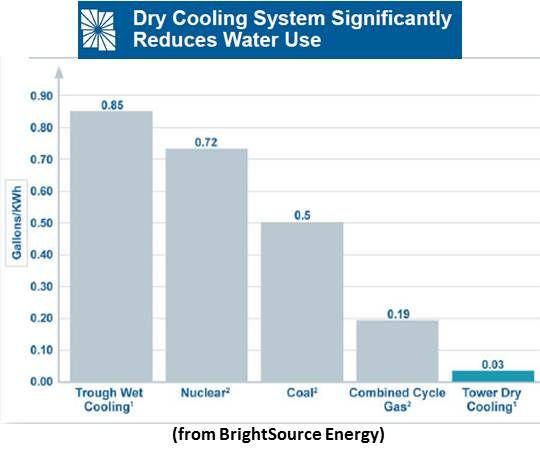The seemingly endless stream of cars coming out of BrightSource Energy’s 370-megawatt Ivanpah solar power plant complex bolsters the company’s recent declarations about its growth and the progress of the U.S. concentrating solar power (CSP) sector.
“We’ve got 1,700 [people] at work,” said BrightSource Vice President for Government Affairs and Communications Joe Desmond. He added, many are from California’s Inland Empire, where unemployment reached 15 percent at the height of the Great Recession. “These are family-wage jobs. They’re electricians, pipefitters, welders, heavy equipment operators, engineers and biologists.” There is also a helmets-to-hardhats program designed for veterans.
“People talk about the CSP industry being dormant or paused,” explained BrightSource Communications Director Keely Wachs. “Last year, PV had a banner year. The industry installed 868 megawatts in the U.S.,” said Wachs. “Now, there are 1,200 megawatts of CSP under construction in the U.S. alone, which will mean a 120 percent increase by 2013 over the 530 megawatts of operational CSP in the U.S. today.” And that, he added, “is not including the 3,000-plus megawatts under development.”
Competitors SolarReserve (which has projects under way in Nevada and California) and Abengoa (which is developing in Arizona) would agree. But BrightSource is the biggest. A 29-megawatt plant is on-line, doing enhanced oil recovery (EOR) for Chevron. The three-tower, 370-megawatt Ivanpah project, in Ivanpah, CA, near Las Vegas, is on schedule to go on-line in 2013. And both its three-tower, 500-megawatt Hidden Hills project and its three-tower, 750-megawatt Rio Mesa project are under permitting review by the California Energy Commission, with decisions expected by the middle of 2013.
Altogether, BrightSource expects to have thirteen plants, totaling 2,377 megawatts of capacity, on-line by 2017.

The BrightSource solar power tower technology was developed by the builders of the original CSP trough technology at the nine Solar Energy Generating Stations (SEGS) still in operation today -- and not far from Ivanpah.
“We produce high-temperature, high-pressure steam to turn a turbine,” Desmond explained. And, where it is contracted for, “we transfer heat from the solar field through a heat exchanger to molten salt for storage.” The technology is sophisticated enough that multinational engineering giant Bechtel was brought on at Ivanpah for engineering, procurement and construction (EPC) duties.
The Ivanpah facility without storage, said Desmond, has a 32 percent capacity factor. “A PV panel might have a 21 percent capacity factor,” Desmond went on. “If we add between two and six hours of storage, the capacity factor will be above 50 percent.” More importantly, Desmond added, “when you increase the capacity factor, you’re not necessarily increasing your cost at the same rate. You’re taking your fixed costs and spreading them out over more hours, which helps drive down cost.”
BrightSource is concerned about costs. To minimize transport expense, it has built a heliostat assembly plant at the Ivanpah facility where a union workforce turns flat mirrors into heliostats at the rate of 500 per day.

Moving to air cooling also promises cost savings. With trough technology, he explained, “there was a preference not to go to dry cooling because there was an efficiency loss.” But the tower operates “at a higher temperature and pressure that allows us to offset some of that efficiency change.”
“That is the conversion of thermal energy to electricity -- photon to electron -- efficiency,” Wachs added. “The troughs were about 36 percent. Ivanpah is 42 percent with air cooling. Hidden Hills goes up to almost 44 percent. And when you get to supercritical levels, you get to 46 percent. Like a super-efficient coal plant. That is where we are headed, because of our heliostat design and our ability to understand the sun.”
Water use is also minimized, Wachs added, because the entire system is a closed loop. The steam is condensed to water and recirculated. “We don’t require external water for cooling purposes.”
BrightSource engineers are using on-the-ground experience to find new design efficiencies. “As we go from one project to the next,” Desmond said, “we are figuring out how to do it faster, better, and cheaper. We see that already at Ivanpah. We are ahead of schedule on unit three based on what we’ve learned with work done so far on units one and two.”
A better understanding of the plant’s power block has produced a new design for the Hidden Hills project that, Desmond said, is expected to cost 40 percent more but double the output. Overall, he added, Hidden Hills is projected to be 20 percent less expensive to build.
“This is our roadmap for driving down costs,” Desmond said. “When the original SEGS plants were built here in California 25 years ago, from the construction of the first to the ninth plant, the costs came down 50 percent. Our long-term goal is a 50 percent cost reduction from where we are now. That is different from PV. They have already had an opportunity to achieve the volumes that have led to their cost reduction.”



